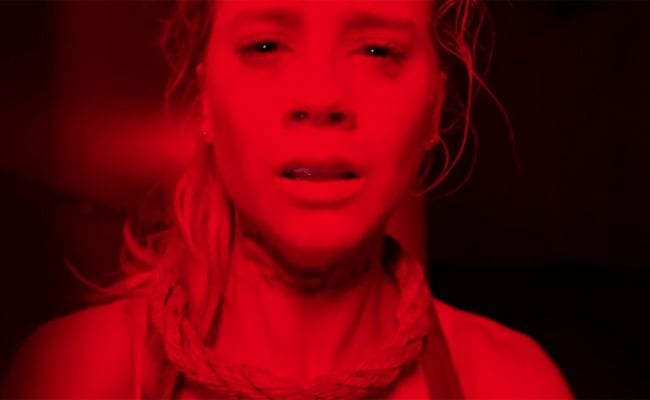
“That is why football players do not do drama!” Ryan (Ryan Shoos), a football player, offers this commentary as Nebraska high school quarterback Reese (Reese Mishler) doesn’t quite finish his last rehearsal for a play called “The Gallows”. It’s true that Reese’s performance is dreadful. It’s also true that in Ryan’s is worse, at least according to the rudimentary moral scale advanced by the movie called The Gallows.
This would be the usual horror movie moral scale, where gadflies, morons, and bullies deserve the bad things that happen to them and the relatively good kids do not. As usual, this mix allows the movie to kill off different victims at varying effects for viewers. You’re not disappointed when the cocky kid with the camera suffers a horrible end, but you might be vaguely disconcerted when his blond and blue-finger-nailed cheerleader girlfriend Cassidy (Cassidy Erin Gifford) is assaulted, if only because she’s been crying into the camera a la The Blair Witch Project‘s Heather.
Along with Reese and Pfeifer (Pfeifer Brown), the object of Reese’s affection, Cassidy and Ryan are drawn into an increasingly nonsensical plot that begins with a brief introduction of the “found footage” premise. This being yet another take on this premise by Blumhouse Productions, who made the Paranormal Activities. Though you know that the genre is as troubled as any other (how many last exorcisms must there be?), you might also hope that its categorically low budgets can inspire ingenuity, whether by way of technologies that are new (see: Unfriended) or retro (see: the simple brilliance of the oscillating fan).
The Gallows tries to have it a few ways, incorporating Ryan’s camera, a couple of iPhones with predictably waning batteries, and even a few early images recorded by ancient tech, namely, a 1993 VHS camera. This opening scene also features off-screen commentary on a performance, this by an unknown dad thrilled to see his daughter on stage at a first performance of “The Gallows.” No surprise, this one goes horribly wrong, resulting in the accidental death by hanging of the lead actor, Charlie (Jesse Cross), and the recording turns aptly hectic, the frame careening, the image staticky, the soundtrack full of gasps and screams.
The film underlines that such old-fashioned upset is a suitable response to the horror on screen when it cuts immediately to Ryan’s recording of Reese and Pfeifer ineptly repeating the lines you’ve just heard. His cynical and self-involved annotations aren’t nearly as clever as he assumes (or, as you assume he assumes). That said, your snap judgment of him is not unlike his of the world around him. For an instant, the movie proposes complexity, in your response to it if nowhere else.
That instant being what it is — an instant — The Gallows lurches directly into its more predictable business, which is to subject the four kids at its center to harrowing abuses by an undead monster lurking in the drama department. (It goes without saying that when Ryan is instructed not to say Charlie’s name, he does, again and again, thus calling up his own fate.) Per formula, they get themselves into this mess, entering the high school after hours the night before the performance under the guise of an exceedingly nonsensical scheme, then running directly into scary noises and locked doors. Unable to escape or use their cell phones except as recording devices (otherwise, no movie!), they rush from room to room and floor to floor, stumbling though bulky props and flouncy costumes, unable to see around corners, yelling at each other from behind closed doors.
Their yelling (“Guys! Guys!”) and rushing headlong into darkness make clear their fear and inanity, as the victims make any number of not so smart choices, sometimes occasioning jump scares for your benefit, other times a mix of anxiety and advantage, which is to say, the usual sort of mix, where you know someone shouldn’t take that next step. When the film is not so usual, it hardly seems to know what to do with itself.
The most striking sequence is part forward motion, part ghastly flashback by way of the found footage concept. First, Ryan is left alone, and his inevitable and rather loud end is only heard from behind a locked door. And then the rest of the crew finds his camera. What they see is awful, of course, including the part where Ryan, utterly abject, confronts the hulking shadow of a killer, the camera so conveniently catching all of it. You wait a half beat. And then, Ryan, from off screen, pleads his case: “Dude, I’m sorry!” This is why football players don’t do drama.


![Call for Papers: All Things Reconsidered [MUSIC] May-August 2024](https://www.popmatters.com/wp-content/uploads/2024/04/all-things-reconsidered-call-music-may-2024-720x380.jpg)



